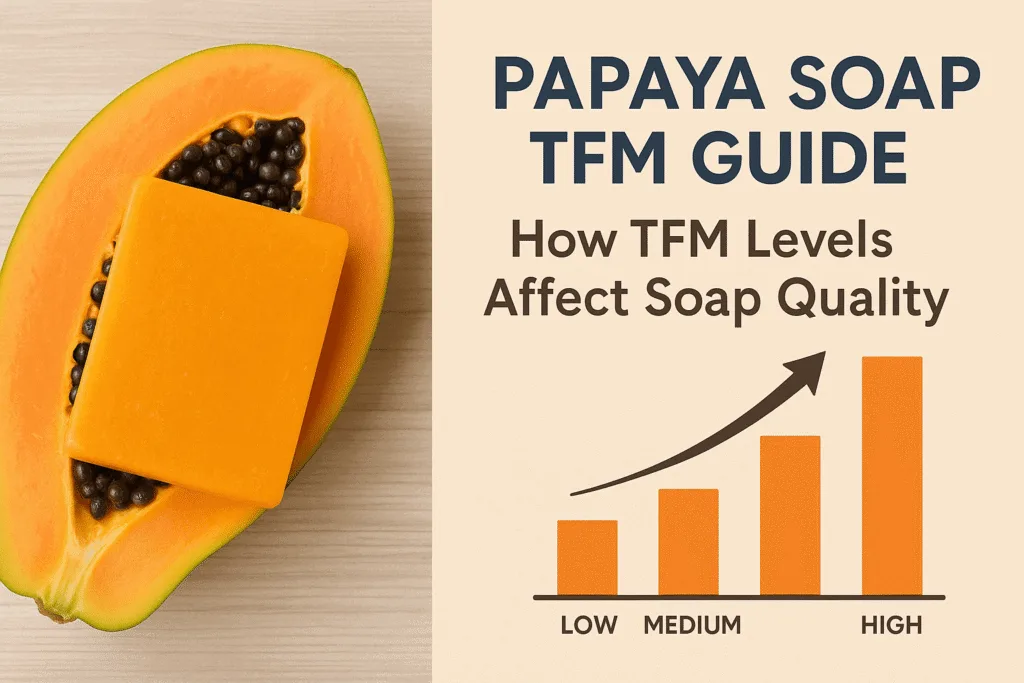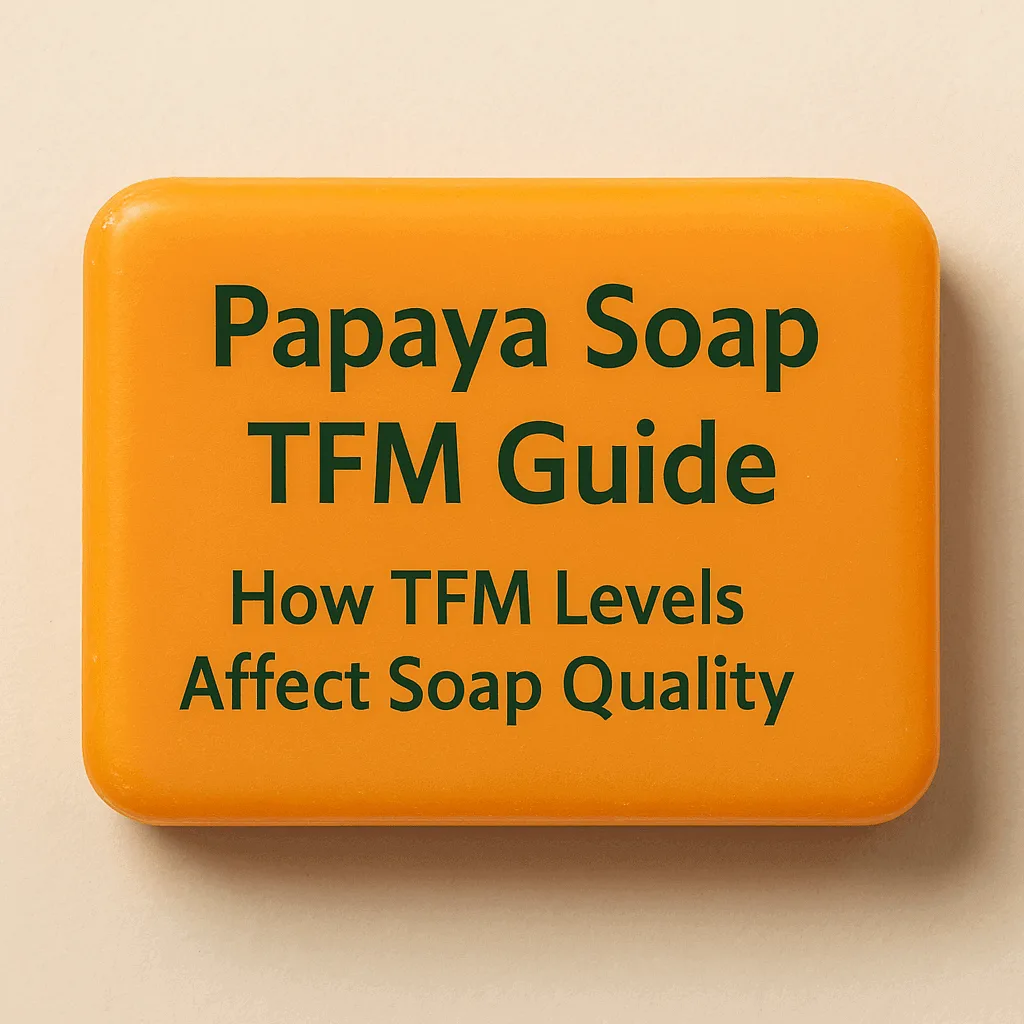Introduction: The Growing Focus on Papaya Soap TFM
In the world of natural skincare, consumers are increasingly savvy about ingredient quality—and nowhere is this more evident than in the rising searches for “Papaya Soap TFM”. TFM, or Total Fatty Matter, has emerged as a key metric for evaluating soap efficacy, especially in herbal formulations like this soap. This article demystifies Papaya Soap TFM, explaining how it influences everything from lather quality to skin hydration. Whether you’re a skincare enthusiast or a casual user, understanding Papaya Soap TFM can help you choose products that deliver on both performance and gentleness.

What Is TFM in Soap and Why It Matters
Defining TFM: The Core of Soap Quality
TFM represents the percentage of fatty acids in soap, a critical indicator of its purity and moisturizing potential. In simple terms, it measures the total fat matter converted into soap during saponification—the process where fats or oils react with alkali to form soap. Higher TFM typically means more natural oils in the final product, translating to richer lather, better skin hydration, and reduced harshness.
The Science Behind TFM
Soaps with higher TFM (typically 76% or above) are considered premium because they retain more of the natural oils’ benefits, such as vitamins and antioxidants. Conversely, lower TFM (below 60%) often indicates more filler ingredients or excess alkali, which can strip skin of moisture. For this soap, where natural papaya enzymes and nourishing oils are key, Papaya Soap TFM becomes even more critical—it directly impacts how gently the soap cleanses and how effectively it delivers skin-beneficial compounds.
As MedicalNewsToday explains, “Soaps with balanced TFM levels maintain a harmonious blend of cleansing power and skin protection, making them ideal for daily use.” This balance is particularly important for this soap, which relies on gentle exfoliation from papain enzymes and hydration from natural oils like coconut or olive oil.
Understanding Papaya Soap TFM: What Makes It Different
The Unique Chemistry of this soap Formulations
this soap stands out for its dual-action formula: papain enzymes exfoliate dead skin, while natural oils moisturize. Papaya Soap TFM reflects the balance between these components. High-quality versions prioritize cold-process or traditional saponification methods, preserving both the papaya extract’s enzymatic activity and the oils’ fatty acids.
How TFM Influences Key Ingredients
- Papaya Enzymes: Higher Papaya Soap TFM means less dilution from harsh chemicals, allowing papain to work more effectively without being neutralized by excess alkali.
- Nourishing Oils: Oils like shea butter or argan oil, rich in fatty acids, contribute directly to TFM. A soap with 80% TFM, for example, might contain more of these oils than a 60% TFM variant, enhancing its hydrating properties.
Common TFM Ranges in Papaya Soap
- Premium/Herbal Formulations: 76–82% TFM, ideal for dry or sensitive skin, as they minimize moisture loss. These products prioritize Papaya Soap TFM to ensure the papaya enzymes and natural oils work in synergy.
- Standard Commercial Versions: 60–75% TFM, balancing affordability with basic cleansing.
- Low-Quality Options: Below 60% TFM, often containing synthetic detergents or alcohol, which can irritate skin over time.
Discover how papaya soap quality varies with different TFM levels to explore how these ranges translate to real-world product performance.
High TFM vs. Low TFM: Effects on Skin Quality
1. Cleansing Power Without Stripping
High Papaya Soap TFM creates a creamy lather that lifts dirt and excess oil without over-cleansing. This is crucial for maintaining the skin’s acid mantle, a protective barrier that low-TFM soaps often damage. As one user with combination skin notes, “My high-TFM papaya soap leaves my skin feeling clean but never tight—a huge difference from the drugstore brands I tried.”
2. Moisturization and Long-Term Hydration
Natural oils in high-TFM soap penetrate the skin’s surface, locking in moisture. A study cited in Healthline found that soaps with TFM above 75% significantly improved skin hydration levels after just two weeks of use. For this soap, this means the exfoliating action of papain is paired with sustained nourishment, ideal for tropical climates where skin is prone to dryness from air conditioning or sun exposure. The correlation between Papaya Soap TFM and hydration makes it a key factor for daily use.
3. Gentleness for Sensitive Skin
Low TFM often correlates with higher alkali content, which can cause redness or itching, especially for those with eczema or rosacea. In contrast, high Papaya Soap TFM acts as a buffer, reducing the soap’s pH and making it milder. Dermatologists frequently recommend such formulations, noting that “the combination of papaya’s anti-inflammatory properties and high TFM creates a soothing effect even for reactive skin types.”
Explore the connection between TFM content and effective papaya soap to understand how these factors interact in premium formulations.
Real Examples: Papaya Soaps with Different TFM Levels
Case 1: Premium Organic Papaya Soap (80% TFM)
- Performance: Rich, conditioning lather; noticeable softness after rinsing. The high Papaya Soap TFM ensures the papaya enzymes remain active while delivering deep hydration.
- Skin Impact: Ideal for aging or dry skin, as the high TFM enhances the absorption of papaya’s vitamin C and antioxidants.
- Downside: Slightly softer texture, requiring careful storage to prevent melting.
Case 2: Mid-Range Papaya Soap (70% TFM)
- Performance: Balanced cleansing, suitable for daily use on oily or combination skin.
- Skin Impact: Effective at removing sunscreen residue or pollution without over-drying, thanks to a moderate Papaya Soap TFM that balances cleansing and moisture.
- Formulation: Contains glycerin (a byproduct of saponification), which boosts TFM and acts as a humectant.
Case 3: Budget Papaya Soap (55% TFM)
- Performance: Stripping lather, leaves skin feeling tight. The low Papaya Soap TFM means fewer natural oils and more synthetic additives.
- Skin Impact: Short-term cleansing but long-term dryness; papaya extract is often diluted, reducing enzymatic benefits.
- Red Flag: May include sodium lauryl sulfate (SLS) to compensate for low TFM, a known irritant.
What to Look for When Choosing a High-Quality this soap
1. Check the TFM Label
While not all brands list TFM explicitly, premium products often highlight “high TFM” or “nourishing oil blend” on packaging. Look for terms like “cold-processed” or “triple-milled,” which indicate methods that preserve fatty acids and support optimal Papaya Soap TFM.
2. Prioritize Natural Oils in Ingredients
Coconut oil, olive oil, and shea butter are key TFM contributors. Avoid products where water, alcohol, or synthetic surfactants appear in the first three ingredients—a sign of low TFM and potential skin irritation. A high Papaya Soap TFM relies on these natural oils for both cleansing and hydration.
3. Read User Reviews for Hydration Feedback
Phrases like “doesn’t dry out my skin” or “leaves a soft glow” often signal adequate TFM. Conversely, complaints about tightness or flakiness suggest lower TFM or harsh additives, indicating a lack of the benefits associated with proper Papaya Soap TFM.
4. Trust Brands Transparent About Saponification
Companies that detail their production process—especially those using traditional methods—are more likely to deliver consistent TFM quality. Learn what makes a papaya soap with high TFM better for your skin by exploring brands that prioritize natural ingredients and ethical manufacturing, ensuring your chosen product maximizes Papaya Soap TFM benefits.

Final Thoughts: Why TFM Levels Are a Key Indicator of Good Skincare Soap
Papaya Soap TFM is more than a technical term; it’s a window into the soap’s soul. A high TFM score indicates a commitment to natural, effective ingredients that work in harmony with your skin—preserving moisture, enhancing papaya’s benefits, and ensuring long-term health. As the skincare industry moves toward transparency, understanding Papaya Soap TFM empowers you to choose products that align with your skin’s needs, whether you seek gentle exfoliation, deep hydration, or simply a trustworthy daily cleanser.
By prioritizing Papaya Soap TFM, you’re not just buying a soap—you’re investing in a skincare experience that balances science and nature. So the next time you shop, remember: higher TFM often means happier skin. Ready to explore what a high-TFM this soap can do for you? Find out why high TFM papaya soap is preferred for daily skincare and discover the difference for yourself.